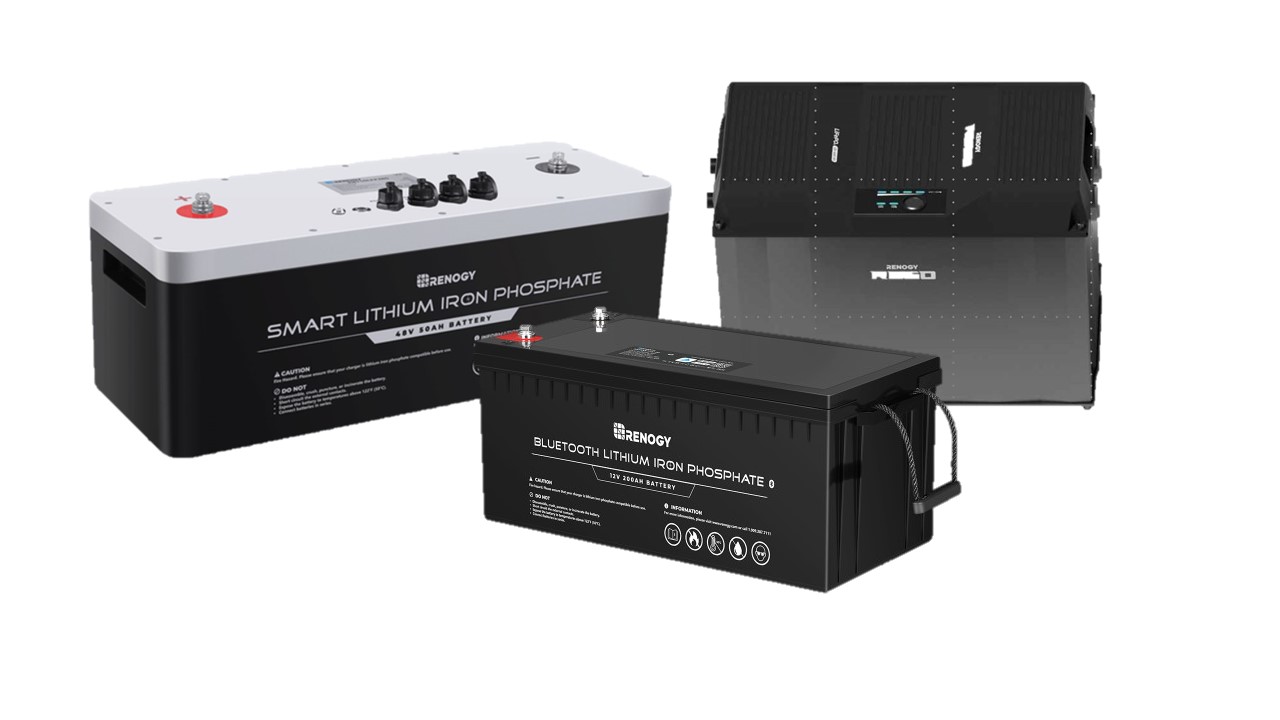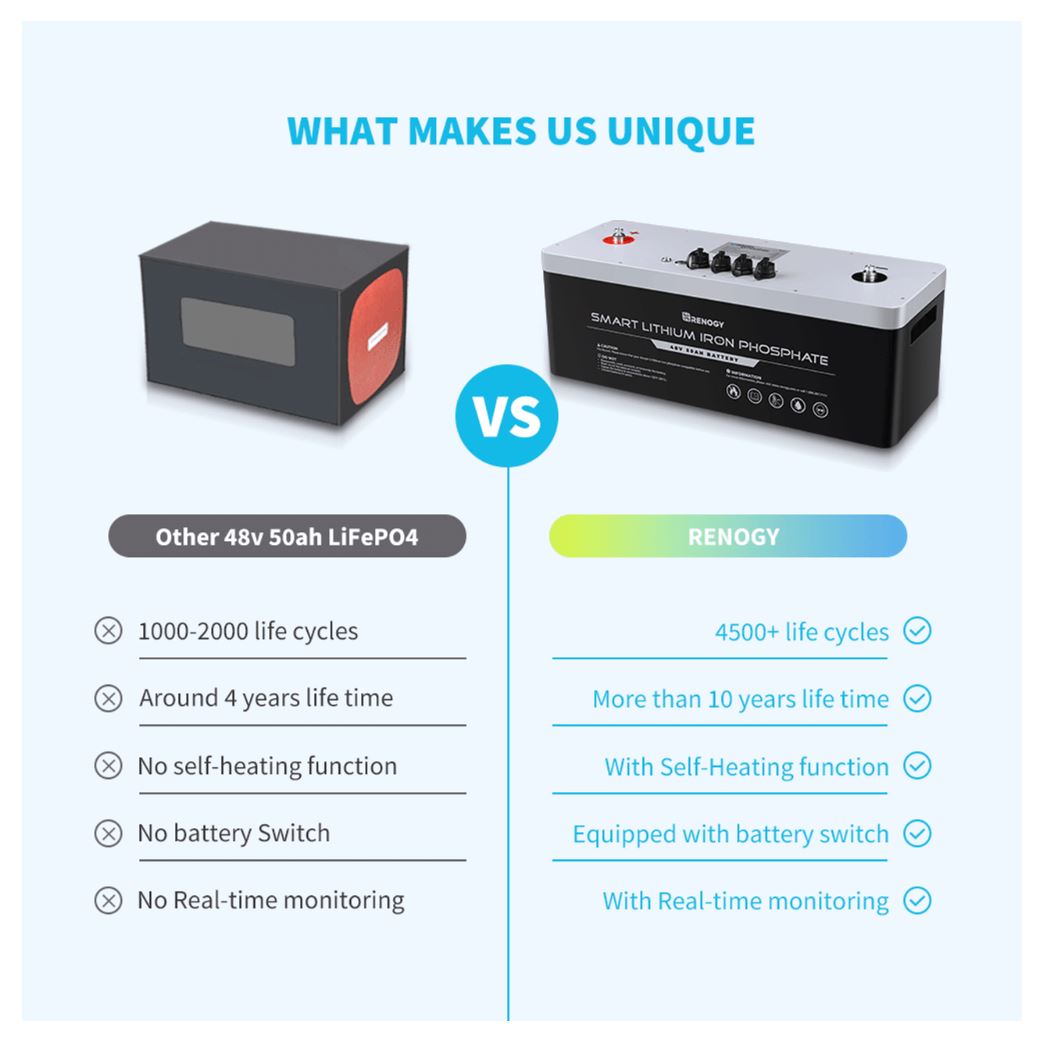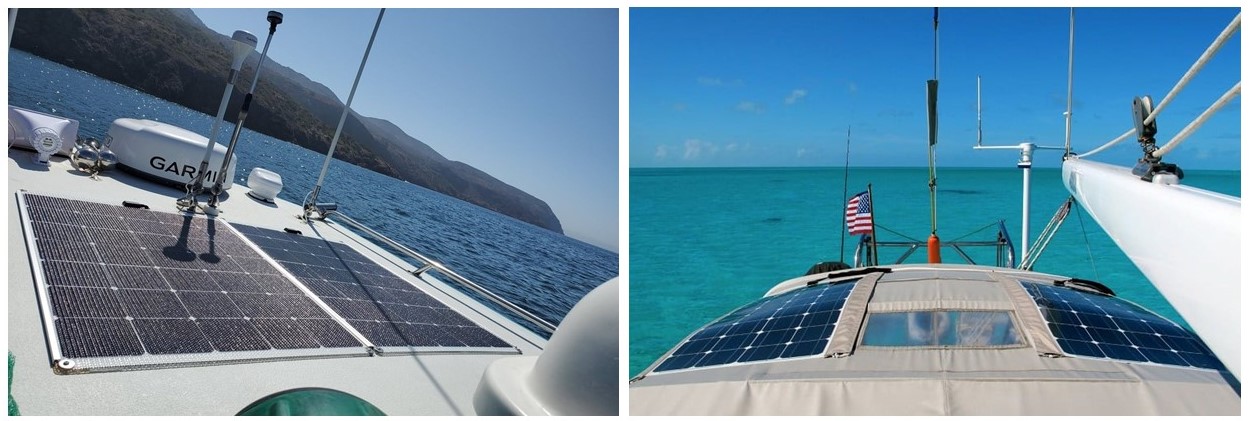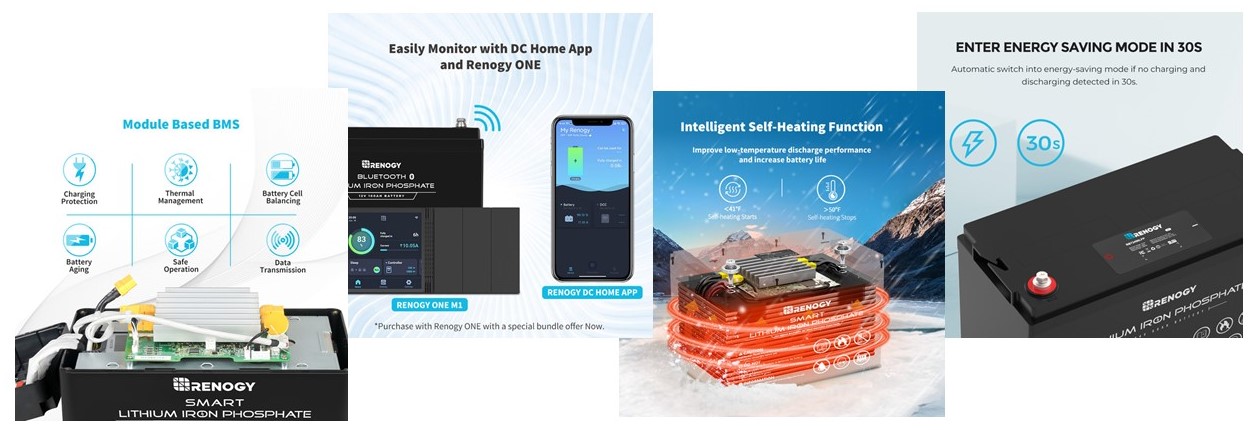What to Consider When Choosing a Marine Battery?
Along with solar charging options, significant advances in battery technology in the last 5 years have many boat owners finding new solutions to powering their off-grid dreams out on the open water. The latest technology in Lithium Iron Phosphate batteries will provide boat owners with reliable power that will last at least a decade.
What is a Marine Battery?
There are three types of marine batteries: cranking, deep cycle, and dual purpose. A cranking battery is also known as a starting battery. Deep cycle marine batteries supply the electronics on your boat such as lights, radio, sound system, fans, water pump, water heater, GPS, etc. with constant, even power over the course of a day or several days. Marine dual purpose batteries combine the performance of a starting and deep cycle battery, and are a good choice on smaller boats when there’s no room for multiple batteries. But, while dual purpose are able to perform the tasks of a starting battery and deep cycle battery, they are not nearly as efficient as a separate starting battery and deep cycle battery. If you are seeking to live or work from your boat and want to be off-grid, or plan to use electric propulsion, you will want a long lasting, high power, deep cycle marine battery bank to meet your needs.
Types of Marine Batteries
Now that you understand the purpose of different marine batteries, let’s discuss their chemistry to help determine the best deep cycle marine batteries for your needs.
Lead Acid (LA) is the traditional large capacity battery that has been around for decades. These batteries use lead compounds for the anode and cathode material and a liquid acid for the electrolyte. The downsides of LA batteries include the potential to off-gas or “boil” the electrolyte solution during charging, so it’s important to have Lead Acid batteries stored in a vented location outside of the living space.
Sealed Lead Acid (SLA) offers improvements over traditional LA batteries, and comes in either Gel or AGM configurations. While Gel uses a sulfuric acid electrolyte solution mixed with an ultra fine silica powder that turns it into a gel, AGM uses an absorbent glass mat which allows the acidic solution to flow through the fiberglass material. Both of these batteries are considered “sealed,” creating less potential for off-gassing, and can be installed in a variety of orientations. These batteries are a good option if you don’t use your boat very often as they are good quality at an affordable price.
Lithium Iron Phosphate (LFP or LiFePo) is a type of Lithium Ion battery that is specifically designed with larger capacity applications in mind, and uses non-toxic materials. By using the LFP compound as a cathode material, these batteries are far more stable than some other forms of Lithium Ion batteries. These sealed batteries offer many improvements to all types of LA and SLA batteries. They are less than half the weight, offer a 30% greater depth of discharge (DOD), a 2,000 - 4,500 cycle lifespan, in addition to increased installation options and many other features which increase efficiency. Because of the longer lifespan, and many other positive improvements, LFP batteries are the most cost-effective battery investment especially if you plan to take long trips away from shore power and/or live or work aboard your boat.

Renogy offers LFP batteries in a variety of sizes and voltages including four different 12V options ( 12V-50Ah, 12V-100Ah, 12V-200Ah, 12V-400Ah), two 24V options (24V-25Ah and 24V-50Ah), and a 48V option (48V-50Ah). If you will be using your boat in sub-freezing conditions, you’ll want to consider a self-heating battery such as the 12V-100Ah LFP, 48V-50Ah LFP battery, or the massive REGO 12V-400Ah LFP battery. Each of these batteries has a built-in thermostat which senses when the core temperature of the battery has dropped to 41 degrees F. At this temperature, a small heater turns on and warms the battery so that it will maintain an optimal charging temperature. If you are into ice fishing, these self-heating batteries are an ideal choice and can be removed from your boat and used in your fishing shanty.
So, What is the Best 12 Volt Deep Cycle Marine Battery?
If you intend to use your deep cycle marine battery to simply maintain your electrical needs while you cruise between full hook-up marina boat slips, then perhaps you only need to invest in quality sealed lead acid batteries – especially if you only plan to keep your boat for a few years. But if you plan to spend any time off-grid, or anchored in a safe bay for the night, you will want to consider making the investment in LFP. It’s a complete game changer! Even if you plan to upgrade or downsize your boat, LFP batteries will allow you a higher resale value, or you could always transfer them to your latest toy.

Do I Really Need a Marine Battery for My Boat?
It simply depends upon how you intend to use your boat as to whether you need a separate deep cycle marine battery. If you plan to be out on the open water and away from shore power for a couple of days, and/or use electric propulsion to reduce your dependence on fossil fuels to get around your favorite waterway, then a large capacity LFP deep cycle marine battery will power your electronics and appliances much more efficiently.
How Long Do Marine Batteries Last?
How you use your battery will determine how long it will actually last, so the estimates you see online as well as personal experiences will vary greatly. We were frustrated by the fact that no other resource that we found offered a side-by-side comparison of lifespan by number of cycles. In our comprehensive battery comparison article, we gave this question the science treatment. We calculated how long a marine deep cycle battery lasts if you used 1 full cycle per day. We found that a common Lead Acid battery with an average 250 cycles will last 0.68 years. Compare that with AGM at 1.23 years, Gel at 2.1 years and a Renogy 12V-100Ah Smart LFP battery with 4000 cycles will last up to 10.9 years. While the upfront cost of LFP batteries can be a bit intimidating, their longevity, capacity, and weight all make this investment in your boating adventures worthwhile. So, if you intend to keep your boat for off-grid use for more than a few years, the investment in Lithium Iron Phosphate is absolutely worth it.

How Do You Charge a Marine Battery?
All marine batteries store direct current (DC) power, so require a DC power source. In general, there are 3 ways to charge marine batteries:
- Solar Power (DC) - via a Solar Charge Controller
- Engine Power (DC) - via a DC to DC Charger
- Shore Power (AC) - via an AC to DC Charger, Converter, or Inverter Charger
Solar Power - When illuminated by the sun, solar panels produce a charging current that could be used to run an appliance directly or charge a battery. Since the atmospheric conditions can change throughout a day with clouds, rain, angle of the sun, etc., charge controllers are wired in between the solar panels and the batteries that they are charging. Solar charge controllersregulate the charging voltage and amperage so that the battery doesn’t become overcharged, or damaged in any way. As previously mentioned, LA batteries are particularly sensitive to over charging and can off-gas, which has the potential for an accidental fire. Always use an appropriately-sized charge controller when using solar power. Learn more about selecting a charge controller that is compatible with your system here.
Engine Power - Cranking batteries are designed to give a big hit of current to start the engine and then be immediately recharged by the engine’s electrical system via the boat’s alternator. Ironically, the alternator does NOT produce alternating current (AC), it produces DC current, so don’t let the terminology confuse you. However, a deep cycle marine battery cannot adequately be recharged through the boat engine’s trickle charge. Renogy offers various DC to DC chargers (20A-40A-60A options) to help boost that trick charge to more effectively recharge the house battery. These chargers take the DC engine charge, and boost it up to provide an effective charging current to the house batteries. There are even Dual Input DC to DC Chargers (30A-50A options) that allow you to combine solar power and engine power. Learn more about selecting a DC to DC charger that is compatible with your system here.
Shore Power - Most boats with live aboard capabilities have a converter connected to the AC/DC control panel that charges the DC batteries anytime you are plugged into shore power. But, if your vessel doesn’t have a converter, you could use a portableAC to DC battery charger that uses alligator clips to the battery terminals, or you could integrate a more complex Inverter Charger into your system which combine the roles of an inverter and AC to DC battery charger into one device. This device includes an automatic transfer switch that detects when the system is plugged into a shore power source, then reverses the flow of electricity from battery discharging to battery charging. More information about choosing and installing inverters can be found in this blog.
When To Replace a Marine Battery?
As previously mentioned, every battery type has a specific number of cycles of discharging and charging, before the interior anode and cathode materials start to degrade. As this is a chemical reaction process, the materials simply can’t keep doing it indefinitely. When you notice that your battery is no longer lasting as long as it has in the past, it’s time to replace it. Once the materials have degraded within the battery, it will no longer function properly.
Cycles refer to charging cycles, that is using a battery to its safe depth of discharge (from 100% to 20% for LFP -OR- 100% to 50% for LA and SLA) and charging back up to 100% again. So, let’s say that you use half of your battery’s usable capacity during one day and charge it back up to full, then do the same thing the next day – this would only use 1 full cycle. The number of cycles varies significantly based upon the battery chemistry – from 200-300 cycles for traditional LA and up to 4500 for some LFP batteries. Learn more about cycles for various batteries in this blog.

How to Prevent Marine Batteries’ Problems?
Common problems from batteries come from either over discharging the battery and/or storing it in environments that are too hot or too cold. Most LA and SLA batteries do not have low voltage internal monitors to prevent over discharge like modern smart LFP batteries with BMS. So, it’s a good idea to use a battery monitor which can alert you when your batteries start approaching that safe DOD. The Renogy 500A Battery Monitor and Renogy ONE Core both offer options to set an alarm at specific low battery percentages. Also, many battery inverters have a low voltage cut-off to protect the appliances plugged into it, which can also help protect your batteries. Finally, boats with an onboard gas powered generator may have an automatic start-up function when your battery reaches a specific low voltage.
Exposing a battery to extreme cold, like leaving it in the boat during winter storage if you live in a cold climate, can greatly reduce the expected lifespan. Each specific battery type has a storage temperature range, so be sure to look those up if you’ll be storing your boat in some extremely cold climates. If you are concerned about this, simply remove the batteries from your boat and store them in the garage or basement to minimize this problem. But, if you are living on your boat in below freezing temperatures, a self-heating LFP battery as mentioned above can keep the internal battery temperature above 41 degrees, allowing it to charge effectively and efficiently as long as it gets at least 4A coming from an external power source. You’ll never have to worry about your batteries and colder temperatures again! Another game changer.
So, what is the best 12 volt deep cycle marine battery?
It all depends upon what you intend to power, how long you intend to use it, your space and weight considerations, and lastly, your budget. Renogy has options that can fit into everyone’s criteria!

In 2012, Shari Galiardi & David Hutchison left behind careers and a comfortable home in North Carolina to travel with the vintage camper trailer they lovingly restored, outfitted with solar, and named "Hamlet." What began as a short break from careers and responsibility quickly turned into a love affair with roadlife. They have parlayed their higher education backgrounds, desire for life-long learning, and thirst for adventure travel into writing, photography, video production, and public speaking gigs from coast to coast. Known to their friends as simply Shari & Hutch, you can learn more about their full-time, solar-powered adventures on their website at freedominacan.com. Or, follow them on Facebook, Instagram, and YouTube as “Freedom in a Can, LLC.”








